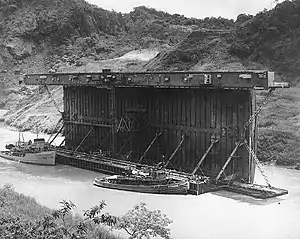USS AFDM-3
USS AFDM-3, (former YFD-6), was the lead ship of the AFDM-3-class floating dry dock built in 1943 and operated by the United States Navy.[1]
 USS YFD-6 | |
| History | |
|---|---|
| Name | YFD-6 |
| Builder | Chicago Bridge & Iron Company |
| Laid down | January 1943 |
| Acquired | 1 December 1943 |
| Commissioned | 9 December 1943 |
| Reclassified | AFDM-3, 1946 |
| Stricken | 15 November 2000 |
| Identification |
|
| Honors and awards | See Awards |
| Fate |
|
| General characteristics | |
| Class and type | AFDM-3-class floating drydock |
| Displacement |
|
| Length | 622 ft 10 in (189.84 m) |
| Beam | 124 ft 0 in (37.80 m) |
| Draft | 7–15 ft (2.1–4.6 m) |
| Complement | 4 officers, 146 enlisted |
Construction and career
YFD-6 was built at the Chicago Bridge and Iron Shipyard, in Chicago, Illinois in January 1943. She was commissioned on 9 December 1943.[2]
From 24 to 26 June 1944, USS Larch (YN-16) was dry-docked inside YFD-6.[3] In late December 1944, USS Arikara (AT-98) voyaged to Trinidad where she took YFD-6 in tow before continuing on to the Panama Canal.[4] On 26 June 1945, YFD-6 was prepared transiting the Panama Canal, circa 1945. YFD-6's center section fully turned 90 degrees, floating on its side with the support of a thousand Navy pontoons installed atop the wing wall. This work, done by Navy SeaBees, was necessary to allow the drydock section to fit through the canal's locks. USS YT-355, USS Alarka (YTB-229) and USS Umpqua (ATA-209) guided and towed the dry dock through the canal.[5][6] In AUgust 1946, the dry dock was re-designated as AFDM-3. USS Gauger (YO-55) towed AFDM-3 and steaming in company with USS Bluebird (ASR-19), USS Cahuilla (ATF-152) and USS Tawakoni (ATF-114), she reached Pearl Harbor on 12 October 1946.[7] In latter 1948, AFDM-3 and USS AFDM-7 arrived at the Balboa yard to be prepared to transit the Panama Canal similarly to the USS AFDM-1.[8]
Throughout 1950, The US Navy done heavy workload on AFDM-3, USS AFDM-7 and USS AFDM-9.[9]
In 1986, AFDM-3, USS ARD-10 and USS ARD-16 were all laid up in Mobile, Alabama.[10]
In 1999, the dry dock was leased to the Bender Shipbuilding and Repair Company.[11]
The AFDM-6 was struck from the Naval Register on 15 November 2000.[1] On 1 April 2002, it was sold to the company in Mobile.[11]
In 2010, the Bender Shipbuilding Company was declared bankrupt thus all systems were acquired by the Signal International. After 2018, the shipyard was sold to World Marine of Alabama.[12]
References
- "AFDM-3". Naval Vessel Register. 6 June 2002. Retrieved 8 February 2022.
- "Auxiliary Floating Dry Dock (AFDM)". www.navsource.org. Retrieved 8 February 2022.
- "Larch (YN-16)". public1.nhhcaws.local. Retrieved 8 February 2022.
- "Arikara (AT-98)". public1.nhhcaws.local. Retrieved 8 February 2022.
- "NH 98828 Floating drydock YFD-6 (center section)". public1.nhhcaws.local. Retrieved 8 February 2022.
- "NH 98829 Floating drydock YFD-6 (center section)". public2.nhhcaws.local. Retrieved 8 February 2022.
- "Gauger". public1.nhhcaws.local. Retrieved 8 February 2022.
- Governor, Canal Zone Office of the (1948). Annual Report of the Governor of the Panama Canal for the Fiscal Year Ended ... U.S. Government Printing Office. p. 30.
- Governor, Canal Zone (1935). Report. U.S. Government Printing Office. p. 37.
- The Port of Mobile, Alabama. The Corps. 1986. p. 93.
- States, United (13 July 2000). United States Statutes at Large. U.S. Government Printing Office. p. 114 STAT. 533.
- "BENDER SHIPBUILDING". Ship Building History. 8 October 2020. Retrieved 8 February 2022.